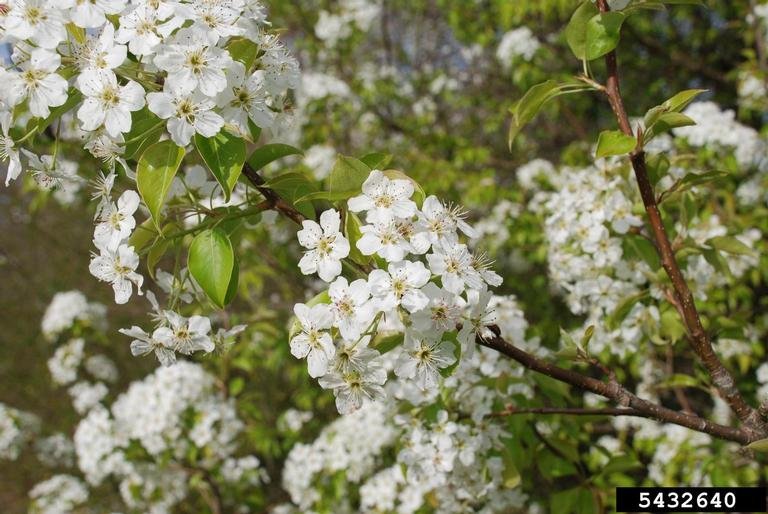
Ornamental Pear Tree Facts
Background image source: Nancy Loewenstein, Auburn University, Bugwood.orgIdentification & Biology
Callery pear is a deciduous tree that can grow up to 60 ft (18 m) in height and 2 ft (0.6 m) in diameter. Flowers are showy, white in color, malodorous, have 5 petals and are 1 in wide. They appear in early spring (April to May) before leaves emerge, and are insect pollinated. Fruits are round, typically 0.5 in in diameter (although this can vary), and green to brown in color. Leaves are alternate, simple, 2-3 in long, petiolate, shiny with wavy, slightly toothed margins, and turn a dark red color in the fall. Though most cultivars lack thorns, escaped Callery pear infestations often revert to wild-type, growing in thickets and producing thorn-like branches. It is fast-growing, but rather short-lived (30-50 years) tree and its poor branching structure is prone to ice and storm damage.
Image source: Michasia Dowdy, University of Georgia, Bugwood.orgLook-Alike Trees
Native serviceberry, wild plum, and crabapple species bloom about the same time as Callery pears and have white flowers. Serviceberry petals are brighter white, star-shaped and wavy with space between, as opposed to rounded and close together for the invasive ornamental pear. Native plums have stamens that are longer than the petals. Apple and crabapple flowers can vary from white with a pinkish hue to fully pink, and apple tree branches are nearer to horizontal and less uniform compared to the vertical, symmetrical branching of Callery pear.
Image source: James H. Miller, USDA Forest Service, Bugwood.orgHabitat & Distribution
Callery pear has been found in various disturbed habitats, including degraded open woodlands, woodland borders, thickets, fence rows, wetlands, and fallow fields. This invasive tree adapts to full or partial sun, moist to dry-mesic conditions, and soil containing loam, clay-loam, or sandy loam and is somewhat drought tolerant. The pH of the soil can be acidic to alkaline. Winter cold is tolerated to Zone 5. It is commonly spotted growing along roadsides and in fallow farm fields. Callery pear has rapidly spread throughout Indiana and the eastern US and is rapidly spreading through other midwestern as well as western states.
Image source: Chuck Bargeron, University of Georgia, Bugwood.orgEcological Threat
Callery pear and its cultivars can cross-pollinate to produce fertile fruit, which is eaten by birds, who then disperse the seeds widely. Additionally, fertile pear varieties are commonly used as the rootstock when grafting, and if the grafted crown is damaged the fertile rootstock can then dominate, producing viable fruit. Once established Callery pear forms dense thickets that push out other plants including native species that can’t tolerate deep shade or compete for water, soil and space. Because it can adapt to a wide variety of conditions, it is a significant threat to native grasslands and grassland wildlife, but also invades forested areas. In urban and landscaped areas, it poses a threat because it is a weak tree that is easily damaged by ice and wind, commonly resulting in utility outages, property damage, and safety hazards.
Image source: James H. Miller, USDA Forest Service, Bugwood.org




